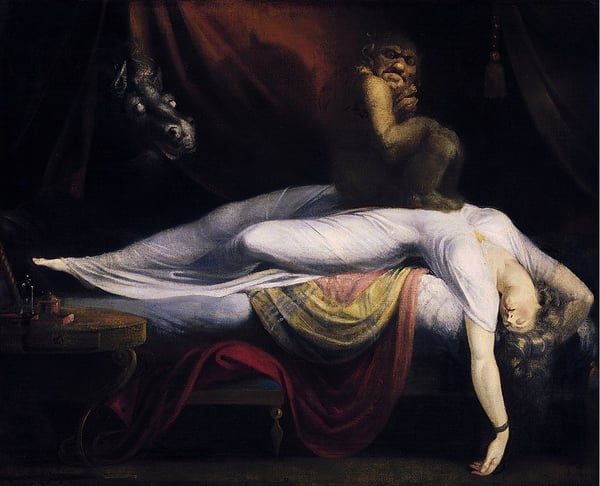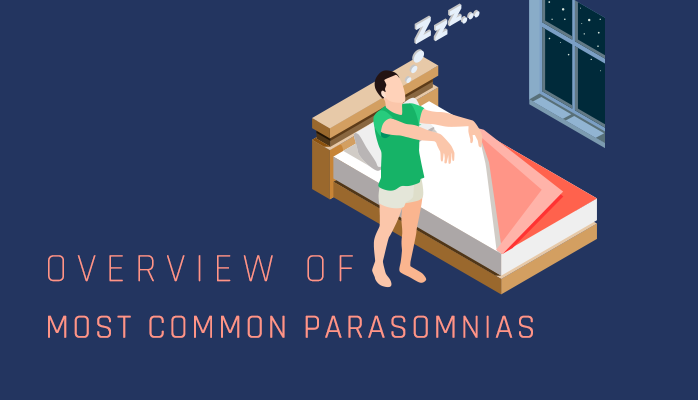What are Parasomnias
Parasomnias are not a single sleep disorder, but rather a collection of sleep disorders that disrupt your circadian rhythm and impact sleep quality. Some parasomnias are nothing more than a nuisance to your bed partner or others in your household.
People often need others to inform them of their parasomnia, as parasomnias may not be remembered in the morning, such as sleepwalking, night terrors, sleep talking, etc.
What are the Different Types of Parasomnias
There is a long list of parasomnias, but the most common ones that we will look are:
- Sleep talking
- Sleepwalking
- Night terrors
- Sleep paralysis
Other sleep disorders that are not discussed in this article include:
- Nocturnal paroxysmal dystonia (NPD)
- Sleep bruxism (teeth grinding)
- REM sleep behavior disorder
- Sleep related painful erections
Overview of Sleepwalking
Sleepwalking, a phenomenon we are all familiar with, is when you appear to be awake and moving around while actually being asleep. Although sleepwalking can lead to humorous situations, it can also pose mild danger to the sleepwalker. For instance, sleepwalkers may unknowingly engage in bizarre activities, such as mistaking the dishwasher for a toilet and urinating in it, or even falling and injuring themselves.
If you happen to come across a sleepwalker, it is important to remain calm and gently wake them. It is not uncommon for sleepwalkers to feel agitated and confused upon waking.
Here are some key facts about sleepwalking:
- It typically occurs during non-REM sleep, specifically stages three and four.
- Sleepwalking often takes place early in the night, but it can also happen during REM sleep in the early morning.
- Although it is most commonly observed in children aged 5 to 12, sleepwalking can occur in individuals outside of this age range as well.
- Sleepwalkers have no recollection of their sleepwalking episodes in the morning.
Waking a sleepwalker poses no danger to either the sleepwalker or yourself, but it should be done gently. Just imagine going to bed in your room and waking up in an entirely different location – it can be quite disorienting!
Overview of Sleep Talking
Sleep talking is a fascinating parasomnia that many of us have experienced or witnessed. It involves the act of speaking while asleep, often with brief and simple sounds like single words, laughter, or mumbling. However, it can also manifest as lengthy speeches by the sleeper. Interestingly, sleep talkers have no memory of their nighttime conversations upon waking.
While sleep talking may not bother the sleep talker, it can be quite distracting or disruptive for their bed partner. The causes of sleep talking are often internal factors such as fever, stress, or other sleep disorders. It is more commonly observed in children than adults, and most children tend to outgrow this habit by their teenage years.
Overview of Night Terrors
Night terrors, also known as sleep terrors, are a frightening occurrence where an individual acts out an intense nightmare, often accompanied by yelling or thrashing. Upon awakening, the sleeper is filled with terror and confusion, unable to communicate their experience. Individuals who have experienced night terrors do not respond to voices and can be difficult to fully wake up.
Night terrors are more commonly seen in children, which can be quite distressing for parents. However, they can also occur in individuals with PTSD. Here are some key points to understand about night terrors:
They are more prevalent in children, causing concern for parents.
- Night terrors typically last for about 15-20 minutes, after which the sleeper may fully awaken with the help of a partner or return to sleep.
- Sleepers have no recollection of their night terror upon waking.
- Night terrors occur during deep sleep and are similar to nightmares.
If someone is experiencing a night terror, it is important to remain calm and gently try to wake them. They may be agitated, confused, and scared. Contrary to popular belief, individuals are not dangerous after waking from a night terror; they may simply be agitated.
Overview of Sleep Paralysis
 Sleep paralysis is scary that historically people have thought it was the product of demonic presence
Sleep paralysis is scary that historically people have thought it was the product of demonic presence
Sleep paralysis is a scary, sometime terrifying, experience that people have during sleep transitions of either waking up or falling asleep where they can’t move their body or speak. During sleep paralysis, people can move their eyes. These episodes can last anywhere from a few seconds to upwards of a couple of minutes.
The causes of sleep paralysis are not known, though it seems to run in families. It can be chronic, or only happen once.
It can be quite scary for the person who is experiencing the episode, especially the first time. But while it can be very scary, they are not dangerous – there’s no danger of not breathing, permanent paralysis, or anything like that. It’s simply a sleep transition disorder.
However, sleep paralysis is also a common symptom in people who have narcolepsy, and if you are experiencing chronic sleep paralysis in conjunction with other symptoms of narcolepsy (or have concerns about the frequency/intensity of your sleep paralysis), please reach out to us right away. Start by taking this online sleep test.


